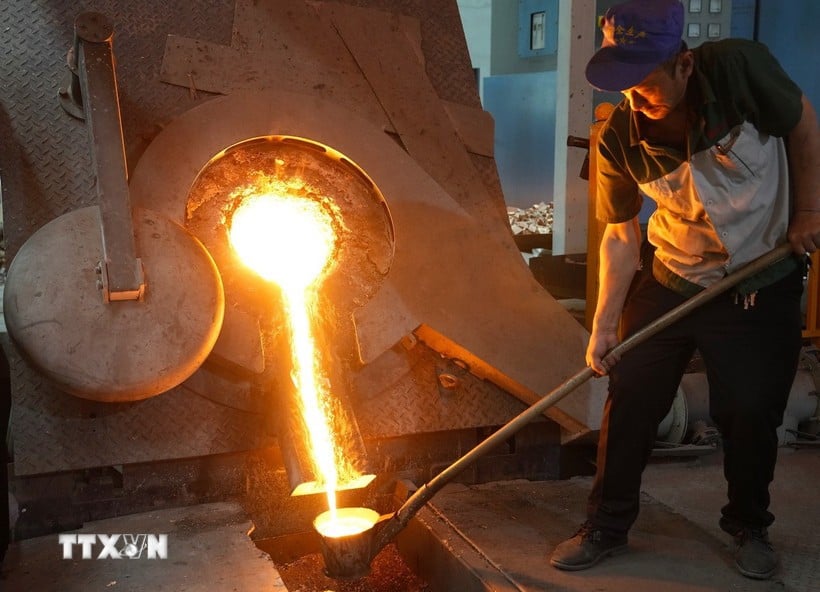Closing the trading session on July 8, the metal market recorded overwhelming buying power; notably, COMEX copper price increased by more than 13% to 12,534 USD/ton, marking a record high ever.

According to the Vietnam Commodity Exchange (MXV), the world raw material market witnessed positive buying power in the trading session on July 8.
Closing, the MXV-Index increased by more than 0.75% to 2,223 points. The main driving force came from the metal group, notably the COMEX copper price which jumped more than 13%.
Besides, the rubber market is also showing positive signals.
At the end of yesterday's trading session, the metal market recorded overwhelming buying power. Notably, COMEX copper prices increased by more than 13% to $12,534/ton, marking an all-time record high.
Yesterday, US President Donald Trump announced that he would impose a 50% tax on all copper imported into the US. Although the official implementation date has not been announced, this information immediately created a strong reaction in the market, with concerns about the risk of short-term supply disruption.
The move follows an investigation launched in February to assess the impact of copper imports on national security, with a deadline of November.
The policy aims to boost domestic production, but the reality is that domestic copper mining and processing capacity is not enough to replace imported supplies if tariffs are suddenly imposed.
This information immediately raised concerns about the risk of supply shortages in the domestic market, as the US currently depends heavily on imported copper for domestic production and consumption.
According to data from the United States Geological Survey (USGS), the United States currently consumes about 1.8 million tons of copper in 2024. However, imports amount to 810,000 tons, accounting for 45% of total demand, with supplies mainly coming from countries such as Chile, Canada, Peru and Congo.
Despite being a large copper producer, the US’s domestic production capacity remains limited. Arizona, which accounts for about 70% of the country’s total copper output, is now placing high hopes on the Resolution copper project, a joint venture between two of the world’s leading mining companies, BHP and Rio Tinto. The project is expected to meet about 25% of domestic copper demand.
However, Resolution is still in the process of reviewing and completing licensing procedures. Therefore, the project cannot be put into operation in the near future.
Amid growing concerns about local supply shortages, the United States has seen a surge in refined copper stockpiling. According to data from the U.S. International Trade Commission, refined copper imports into the country in May alone reached 219,552 tonnes – three times the amount imported in the same period last year.
According to statistics, in the first 5 months of this year, Vietnam only exported 16.3 tons of refined copper to the US market. If the US imposes a 50% tax on imported copper, it will have almost no direct impact on Vietnam's copper products.
Investment cash flow also spread to the industrial market, supporting the price index of this group to have its first recovery session after 4 consecutive sessions of weakness.

At the end of the trading session, the rubber market recorded clear signs of improvement. RSS3 rubber price on the Osaka exchange increased slightly by 0.58% to 2,136 USD/ton, while TSR20 rubber price on the Singapore exchange also increased by nearly 4% to 1,626 USD/ton.
Stable consumption signals continue to be an important driving force supporting the rubber market in recent times. According to the latest forecast from the Association of Natural Rubber Producing Countries (ANRPC), global rubber demand in 2025 is expected to increase by 1.3%, reaching about 15.56 million tons.
Notably, China and India - two markets that consume nearly half of the total global rubber - are forecast to record consumption growth of 2.5% and 3.4%, respectively.
The increase is mainly due to the strong expansion of the automobile industry, especially the demand for high-rubber tires for electric vehicles. In addition, the supply is forecast to increase insignificantly at 0.3%, causing the global rubber shortage to continue.
Thailand's rubber export prospects in the coming months face many challenges as uncertainties related to US tariff policies continue to increase, according to the Office of Industrial Economics .
The impact of trade barriers has caused Thailand's rubber exports to slow down in the coming time. The latest update on natural rubber exports in May shows that Thailand exported only 205,300 tons, down 15.52% compared to the same period last year.
Besides the commercial factor, rubber production in Thailand is also facing difficulties due to unfavorable weather conditions. Prolonged heavy rains in many rubber growing areas have disrupted tapping activities.
In the domestic market, as of July 8, the price of rubber latex remained stable; in which, the price of raw latex fluctuated between 385-425 VND/TSC; mixed latex was purchased at around 351-399 VND/DRC; DRC latex from 35-44% was 13,500 VND/kg; raw latex was 17,200-18,500 VND/kg./.
Source: https://baolangson.vn/gia-dong-tang-vot-khi-hoa-ky-ap-thue-50-voi-tat-ca-mat-hang-dong-nhap-khau-5052660.html


































































































Comment (0)